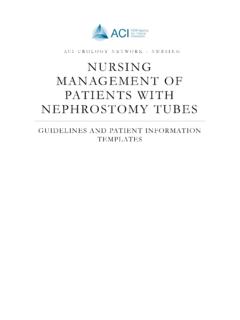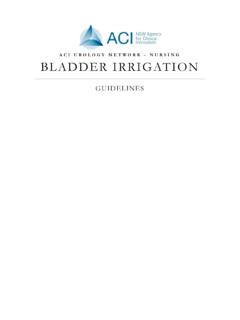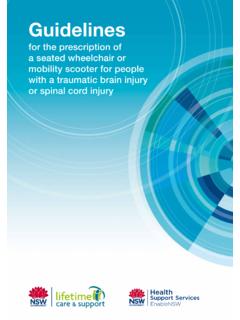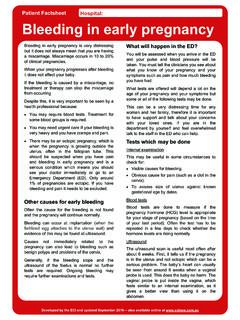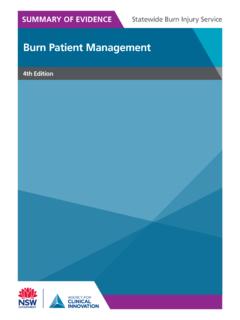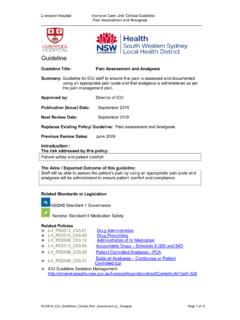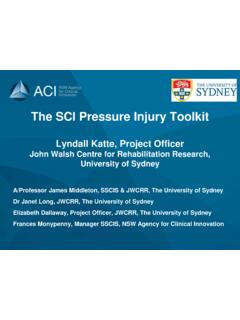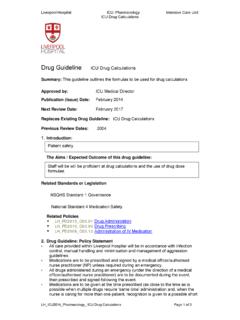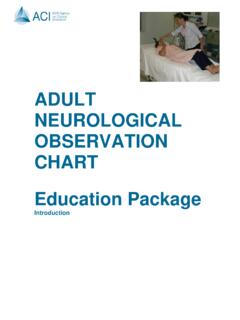Transcription of Triage and Ocular History - Agency for Clinical Innovation
1 Education Session Four Triage and Ocular History EYE EDUCATION FOR EMERGENCY CLINICIANS. EYE EDUCATION FOR EMERGENCY CLINICIANS 1. These presentations have been prepared by: Jillian Grasso, Clinical Nurse Consultant, Ophthalmology Janet Long, Clinical Nurse Consultant Community Liaison, Ophthalmology Joanna McCulloch, Transitional Nurse Practitioner, Ophthalmology Cheryl Moore, Nurse Educator, Ophthalmology Further information contact us at Sydney Hospital & Sydney Eye Hospital: 02 9382 7111. Modules originally designed for emergency nurses as a component of the Eye Emergency Manual Project.
2 December 2008. EYE EDUCATION FOR EMERGENCY CLINICIANS 2. Aim: To provide an overview of Ocular Triage and Ocular History taking Objectives: On completion of this session you will be able to: define the appropriate Triage categories for Ocular conditions ensure that patients are treated according to their Clinical urgency document an effective ophthalmic History This presentation is only focused on Ocular emergency presentations EYE EDUCATION FOR EMERGENCY CLINICIANS 3. the majority of (eye injuries) are superficial in nature and transient in their effects, but place considerable demands on A & E services.
3 (MacEwan 1989). Corneal abrasion Triage 4. Full thickness lid laceration Triage 2. EYE EDUCATION FOR EMERGENCY CLINICIANS 4. Vision Working Reading TV. Ocular History Medication myopic retinal History detachment Ophthalmic History Examples of Specific questions Medical History Family History Diabetes Glaucoma Vitreous Squint/. haemorrhages strabismus Special questions Mechanism of injury - Foreign body Discharge . infection EYE EDUCATION FOR EMERGENCY CLINICIANS 5. On Presentation to Emergency There are two important procedures for Triage to perform at the same time: 1. Eye Examination refer to Education Session Two &.
4 Three for the process of Eye Examination and Visual Acuity. 2. History Taking Both of these will enable you to allocate patient's appropriate Triage category, and facilitate timely treatment EYE EDUCATION FOR EMERGENCY CLINICIANS 6. Overview of Patient History Identify Presenting Problem Patients Previous Ocular History Family Ocular History General Health If patient is a poor historian, culturally and linguistically diverse (CALD), or has difficulty comprehending the questions - base Triage category on eye examination and visual acuity. EYE EDUCATION FOR EMERGENCY CLINICIANS 7. Overview of Patient History Plus EYE EXAMINATION: Provides more clues to fit provisional diagnosis Provides evidence to refute it If the patient has one good' eye only and presents with symptoms in the good eye, referral to an ophthalmologist for review is required.
5 EYE EDUCATION FOR EMERGENCY CLINICIANS 8. Presenting Problem Record primary reason for visit what is the presenting problem? What prompted the visit? Has something new happened, or have symptoms been ongoing for sometime? Why is patient now worried? Caution: some patients may include new symptoms to legitimise the presentation. EYE EDUCATION FOR EMERGENCY CLINICIANS 9. Presenting Problem (cont). First series of questions: Visual acuity was the change sudden or gradual, partial or total loss Affecting one or both eyes Current form of correction is presenting problem contact lens related?
6 Blurry or double vision Red/sore/itchy eye Flashes and floaters/ headaches Recent eye surgery or trauma EYE EDUCATION FOR EMERGENCY CLINICIANS 10. Patient's Ocular History Pre injury vision has the eye always had reduced vision? lazy eye'. Ocular surgery - predispose to infection, wound dehiscence, Intraocular lens (IOL). displacement sudden drop in visual acuity Previous Ocular trauma Airbag related (may get flashes/floaters months later). Use of eye drops how often, when last used, how long has the bottle been open EYE EDUCATION FOR EMERGENCY CLINICIANS 11. Patient's Ocular History (cont).
7 Conditions affecting the other eye. Previous use of contact lenses check for overwear (using daily wear contact lens for 2 - 3 days instead of 1), using correct contact lens solution (not saliva to clean). Ask if they have had corrective/refractive eye surgery (when was their last follow up and when is their next follow up), be aware of people having eye surgery overseas, may not have arranged Ocular follow up EYE EDUCATION FOR EMERGENCY CLINICIANS 12. General Health Systemic conditions especially vascular, inflammatory Medications - (anticoagulants), include all herbal supplements, vitamins, anti malarial Allergies can have bearing on allergic eye conditions lanolin can be used as a base in eye ointments Tetanus immunization status - (if eye trauma).
8 If c/o headaches is there a History of migraine, visual aura's? Recent overseas trips purulent discharge =. ? sexually transmitted infections (STIs). EYE EDUCATION FOR EMERGENCY CLINICIANS 13. Thinking Points -when taking an Ocular History Ask what the eye symptoms are, when first noticed, and what were they doing immediately beforehand (particularly if the onset was sudden). If eye scratched- what, when and force used If possible, test visual acuity at this stage only excluded if serious life threatening condition or chemical injury If chemical injury ask what chemical, time and previous first aid Start irrigation NOW!
9 DON'T WAIT. (Thinking points are adapted from Field & Tillotson 2008). EYE EDUCATION FOR EMERGENCY CLINICIANS 14. Thinking Points -when taking an Ocular History (cont). Record if patient has History of doing any dangerous work. Occupation may give clue to eye problem jack hammering, use of power tools (anything high velocity), ask about use of eye protection Think of corneal foreign body, intraocular foreign body and corneal abrasion. Have they been playing sport. golf, squash & tennis balls fit perfectly in orbit porential ruptured globe or fractured orbit EYE EDUCATION FOR EMERGENCY CLINICIANS 15.
10 Thinking Points -when taking an Ocular History (cont). Document pain level and type try to be accurate, use pain scale, ask detailed questions about exact type, location If analgesia has been taken, was it effective? Try to discriminate between soreness, irritation and stinging . look out for photophobia (sensitivity to light), deep pain in and around eye, severe pain, nausea and vomiting . consider acute glaucoma Ask about family History of eye problems. Some eye conditions can are inherited Cataracts, Glaucoma, Retinal / Corneal Dystrophies and Retinal Detachment EYE EDUCATION FOR EMERGENCY CLINICIANS 16.
